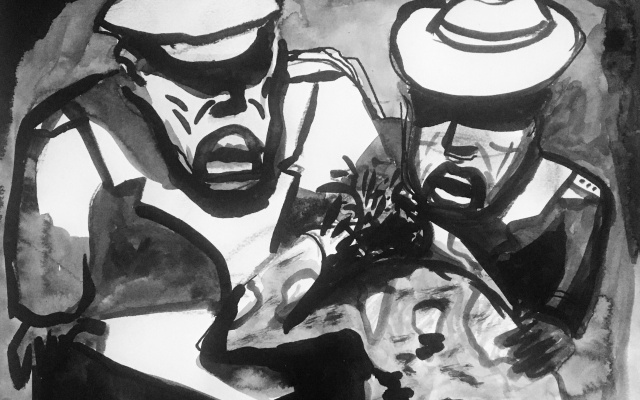The Russian war against Ukraine has brought a number of appearances by Russian officials blaming Ukraine for the war. Foreign minister Sergei Lavrov is a seasoned expert in this particular drill, claiming that even Russian destruction of Ukrainian power plants are “defensive measures”, only to “prevent Ukraine from bombing Russian cities”. In the beginning of the war he claimed the Ukrainian leadership consisted of “nazis”, and, when confronted with the fact that Ukraine’s president is a jew, that “Hitler had Jewish blood”; a statement for which Israel demanded an apology, which they got, personally conveyed by Vladimir Putin.

Jon Eirik Lundber, The Victim Is Interrogated.
Ink on paper, 2022
This conclusion to that case, the perpetrator giving an apology, is highly unusual. It can only be explained, I think, by some special influence Israel can apply towards Russia. Ukraine, for one, does not find such an understanding.
The guilt of the victim is the axis of basically all political criminality. Islamic terrorists applies it routinely. If a Christmas market is bombed, or a teacher beheaded, the reason given is always the actions of the victims. They either failed to convert to the right religion, or they had insulted some sacralised figure, or in some other way acted against the laws of the terrorists, which they claim has global jurisdiction. The phenomenon is in no way isolated to certain cultural or geographical entities; it is global in space as well as in time.
According to some readings of Christianity, Jesus is the first innocent victim. He doesn’t defend himself, he just suffers the ultimate injustice, out of which comes one of the most powerful stories ever told, in terms of effects on human history. But what has all of this to do with art?
Quite a lot, according to the French philosopher Francois Flahault. In his article, “L’artiste-créateur et le culte des restes” (“The artist-creator and the cult of remains”) from 1987, Flahault find contemporary art pieces situated close to the world of religious relics. The objects – religious or artistic - are carrying stories, or the presence, of something important. Almost like the Jewish God the artist is creating “something out of nothing”, and this ability is highly revered. An artist like Ai Weiwei, and many with him, can be understood as getting even closer to the world of relics as they use art to comment on significant issues.
I have earlier mentioned Ai Weiwei works like Straight (breaking a governmental blackout on corruption) and At Large (commemorating political prisoners), but among all his eye-witness pieces the most haunting still might be “S.A.C.R.E.D” (2013). The work consists of realistic representations of situations from his 81 days long incarceration in 2011. No formal charges were put forward to justify the imprisonment, but the harassment can be understood as punishment for his “stubborn efforts to document the names of those killed by official corruption”. In China, accusing the victims is a modus operandi of the state, according to the same article.
For Ai Weiwei this is nothing new. His life began under this heading, growing up with both his parents deported as political enemies of the Communist party. Because of that he began his life a political prisoner himself. It is not hard to understand that this is the root of his credos: that “art is innocent” and that it is “the duty of the artist” to fight for freedom of speech.
The victim’s guilt is essential to the harassment the victims are suffering. Hence it must the duty of every freedom-seeking individual, artist or not, to confront this particular idea, that the victim carries guilt, wherever it manifests itself. But by some bizarre twist of historical logic, it happens to be precisely in the art world of the West that one currently finds the most aggressive version of it.
The number of artists accused of being “controversial” is constantly rising. Like a shadow it follows the current of politically correct ideas related to climate, race and gender. Even though such ideas might be presented as the zenit of liberal reasoning, the treatment of dissenters leaves no traces of anything liberal. On the contrary, artists branded as “controversial” can quickly find themselves in a very lonely place, fully exposed to the social control mechanisms of their surroundings.
The beginning and the end of all such social machinations is the question of guilt. The accusations themselves in part implies a verdict. Supporting the accused means taking a risk of being drawn into the malstrom. Still, if the freedom of speech, and hence of art, is to be protected, there is no way around it. There is a duty of the artist towards society, namley to fight for freedom of speech. But to the same end there must be a duty on part of society, then, in the broadest meaning of the term, to preserve the freedom of the artist.


